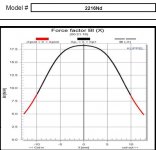Why do you ground one side of the loudspeaker in the first place?
If you have to ground one side, the improved Howland configuration is indeed more suitable for class-AB than configurations with floating output ports and sensing the current at the other side of the port, like they used in the article.
If you have to ground one side, the improved Howland configuration is indeed more suitable for class-AB than configurations with floating output ports and sensing the current at the other side of the port, like they used in the article.
Only one advantage i could think of grounded load. You can parallel current drive amps in such way. But yes no more advantages other than that. IMHOWhy do you ground one side of the loudspeaker in the first place?
If you have to ground one side, the improved Howland configuration is indeed more suitable for class-AB than configurations with floating output ports and sensing the current at the other side of the port, like they used in the article.
Here you can see how the sonsor coil is mounted on a Backes and Müller woofer (sorry not my picture, therefore only a link):
https://www.fidelity-online.de/wp-content/uploads/2019/01/BM-Fertigung-17.jpg
The magnets of the sensor are glued to the pole-piece. The magnetic field of the sensor is perpendicular to the ones emanating from the motor.
Here you can see the same for smaller drivers (quite fiddly for those who have to mount the sensor I would say):
https://www.fidelity-online.de/wp-content/uploads/2019/01/BM-Fertigung-47.jpg
This is the link to the whole article in German:
https://www.fidelity-online.de/backes-mueller-bm-line-80-aktivlautsprecher/
Regards
Charles
https://www.fidelity-online.de/wp-content/uploads/2019/01/BM-Fertigung-17.jpg
The magnets of the sensor are glued to the pole-piece. The magnetic field of the sensor is perpendicular to the ones emanating from the motor.
Here you can see the same for smaller drivers (quite fiddly for those who have to mount the sensor I would say):
https://www.fidelity-online.de/wp-content/uploads/2019/01/BM-Fertigung-47.jpg
This is the link to the whole article in German:
https://www.fidelity-online.de/backes-mueller-bm-line-80-aktivlautsprecher/
Regards
Charles
Last edited:
I managed to measure excursion using a cheap sharp IR sensor:
https://data-bass.ipbhost.com/topic/760-measuring-excursion/
However the update rate is insufficient for real time control. There are fancy laser Interferometry based distance measurement sensors that have been used for motional feedback (I think by realhorns in their 8 driver water-cooled bass horn). https://www.paoftheday.com/a-look-inside-a-realhorns-pa-system/
https://data-bass.ipbhost.com/topic/760-measuring-excursion/
However the update rate is insufficient for real time control. There are fancy laser Interferometry based distance measurement sensors that have been used for motional feedback (I think by realhorns in their 8 driver water-cooled bass horn). https://www.paoftheday.com/a-look-inside-a-realhorns-pa-system/
Last edited:
As far as I understand the concept, one needs acceleration (order 2), not speed (order 1) or excursion (order 0)
If you build a feedback loop that controls speed you would simply have to precondition your driving signal. In this case it would mean to integrate it.
Regartds
Charles
Regartds
Charles
As far as I understand the concept, one needs acceleration (order 2), not speed (order 1) or excursion (order 0)
Doesn't that depend on what you want to control ? As I understand that would be excursion for cone displacement/damage control, velocity for (square root of) kinetic energy control and acceleration for force control ?
displacement based limiting would be pretty cool for PA subs. Incidently powersoft do feedback on mforce drivers using a diffirential presure sensor between the cone front and back.
That one and more.A long time ago, there was an AES article about such a set-up.
I have a bunch of good, cheapish, dual VC woofers. We have usually just wired the 2 coils in series for maximum output.
dave
yes, but mfb is usually applied in order to linearize the woofer, not to protect it.
Yes, motional feedback using acceleration as the control variable must result in more linearity than current feedback, as the latter assumes the BL product (the constant of proportionality relating current and force) to be actually constant which is not often true, even when the woofer is nowhere near Xmax. Let's just take a 15 " woofer from a very expensive high-end studio monitor (the JBL M2) as an example (attached).
Attachments
- Home
- Loudspeakers
- Multi-Way
- second coil on the speaker cone
